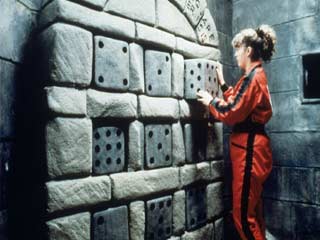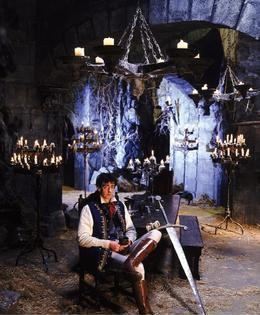The Crystal Maze
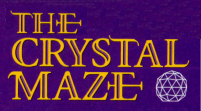
Contents |
Host
Series 1 to 4: Richard O'Brien
Series 5 and 6: Edward Tudor-Pole
Co-hosts
"Mumsy" the fortune teller, played by Sandra Caron
Broadcast
Chatsworth Television for Channel 4, 15th February 1990 to 10th August 1995 (78 shows + 5 specials in 6 series)
Synopsis
Before the show itself, a few words about the structure of the Maze - a huge, custom-built set which was the largest in Europe. Firstly, it wasn't really a maze at all - a better description might be: a circuit of four inter-connecting play areas or "time zones". The four original zones were:
- Aztec - A sand-covered floor flanked by ziggurats on either side and a totem pole.
- Futuristic - A space station filled with neon lights and electronics.
- Medieval - A castle with wooden timbers and stone carvings.
- Industrial - A wasteland of dirty metal doors, disused oil barrels and security fences.
In later series, Industrial was replaced with Ocean - a sunken ship called the S. S. Atlantis. The maze cost something in the region of £250,000 to build and was approximately the size of two football pitches. For the first series, the set was built in Shepperton Studios - one of only two studios in the country that were large enough to accommodate the Maze. However, by the time planning for the second series began, both of the suitable studios were already booked up. The hunt began for a new location, which turned out to be a disused aircraft hangar in North Weald (north-east London).
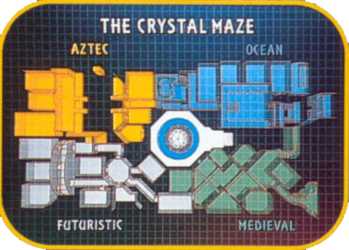 Computer graphic of the maze. This is from series 4 - in previous series, the Ocean zone was Industrial.
Computer graphic of the maze. This is from series 4 - in previous series, the Ocean zone was Industrial.The show in brief
Each show, a different team of six contestants (three male and three female) are led around the Maze by their host Richard O'Brien (pictured). In each zone, the team play three or four games (see below) which are housed in one of six chambers. Although the contestants work as a team, each game is played by a nominated, individual player who enters the cell. The remainder of the team must remain outside the cell, although they are usually allowed to help (or hinder) their team-mate by shouting encouragement and suggestions. Completing a game correctly caused a contraption of some variety to release a time crystal.
Each game was given a time limit of between 2 and 3 minutes. Any contestant who failed to get out of the cell within the time limit (regardless of whether they had the time crystal or not) was locked in the cell. They could be released and play a further part in the show, but only if the team sacrificed one of the team's time crystals.
Once all the time zones have been visited, each time crystal is converted into 5 seconds inside the Crystal Dome. where remaining team members aim to grab flying golden tokens (but avoid grabbing silver tokens) and post them through a letterbox. The performance in the Crystal Dome determines if a prize is won or not.
The games
As explained earlier, the purpose of winning each game was to win a time crystal (one of which can be seen in the picture illustrated here). Each series of Crystal Maze used approximately 50 different games. Each game was categorised as either:
- Physical - Emphasis on being agile, strong and flexible.
- Mental - Basically, word-association and mathematical puzzles
- Skill - Testing dexterity and marksmanship.
- Mystery - Anything at all!
Some games were designated as "automatic lock-in" games. If a player attempts an automatic lock-in game and fails to perform some specified part of the task, or performs some forbidden action (e.g. touching the floor with any part of their body) then they are locked in at once regardless of whether they have obtained the crystal or not. The contestant has no choice as to whether they play an automatic lock-in game or not; they will always hope not to have to play one! Once a player has been locked in, the captain must choose whether to buy them out or not. This decision can be made at any time between two games, so long as there is time for some available team member to return to the cell where the lock-in took place, open the door, deposit one of the team's crystals and return to the rest of the team with the rescued team member. If the team captain is locked in, then the vice-captain takes over the captain's responsibilities. If both captain and vice-captain are locked in (which did happen once or twice) a replacement captain was elected on the spot.
The Crystal Dome
The Dome represents the denouement of the show - the absolute climax where all the time crystals collected are converted into time and, possibly, prizes! All time crystals earned (typically somewhere between four and eight) are worth five seconds worth of collection time each. All the members that are still with the team (remember, some may still be locked in the cells) enter the Dome, a geodesic structure made up from triangular glass panels. There is a thick metal grid mesh placed as a horizontal plane perhaps a metre from the bottom of the Dome, which the contestants stand on, holding onto a handrail lining the inner surface of the Dome. Also on this mesh are lots of gold and silver tokens (625 silver, 500 gold). There are powerful fans underneath the mesh. The host will call for the fans to be started...
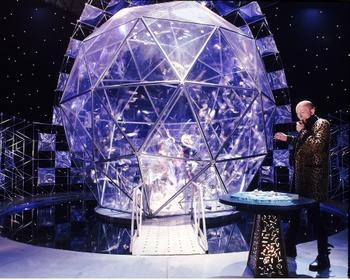 Richard O'Brien with the geodesic Crystal Dome in the background.
Richard O'Brien with the geodesic Crystal Dome in the background.Suddenly, all the gold and silver tokens will fly into the air and circulate throughout the dome. A few seconds later, the host will blow a whistle and the contestants try and collect flying gold tokens and post them through a "magic letterbox". Contestants should be observant and avoid posting silver tokens through. Once the time allowed has expired, the magic letterbox closes and all token-collecting-type activities must stop.
Prizes (or otherwise)
The number of gold and silver tokens collected is counted. Gold tokens count as 1 point, silver tokens count as -1 point. If this total is over 100, then the team win the grand prize, usually an activity holiday of some sort for all six team members. If the total is between 50 and 100, the team win the not-so-grand prize (maybe a day trip somewhere), and any scores less than 50 earn nothing, though win or lose, all contestants get a replica crystal to take home (engraved with "I Cracked the Crystal Maze - 199X"). After series 1, the 50-point prizes were eliminated - the team either had to score over 100 or go home with nothing more than a lump of glass.
Inhabitants
Unlike the French Fort Boyard (upon which The Crystal Maze was based), there were comparatively few people living in the Maze. The only real person we got to see regularly, apart from mein host, was a fortune teller, played by Sandra Caron. She appeared as one of the mystery games in the first series, whereby she would ask the contestants up to three puzzles, one correct answer winning the crystal. After this game, Richard O'Brien would often engage with banter with the woman, pretending that the fortune teller was his mother (or Mumsy) and in future series she was billed as this. A running joke told of the relationship between Mumsy and Ralph the Butler, who we never got to see.
In series 3, Mumsy went to Bratislava so Richard was joined by Mumsy's sister, Aunt Sabrina (again played by Sandra Caron). Sabrina was a 1960s anachronism of bad taste, with the earrings to prove it.
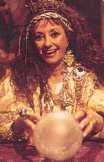 The fortune teller.
The fortune teller.In series 1, one of the more lavishly-produced games involved a confusing, tortuous passageway of mirrors and secret doors. At the centre of the maze was a sleeping princess, and kissing her woke her up and gave you the crystal. (She was the producer's daughter.)
In series 5, another game contained a knight (given the droll name Lance by the production team) played by Dennis Price. He asked you to put together a stamp which, when impressed into some soft clay, would give "the king's seal". Of course, you had to remember to construct the stamp back-to-front so that it would look correct when it make the impression in the clay. Dennis returned in series 6, as one of the three Aztec priests found inside a maze.
The only other inhabitant, if that's the right word, was the computer in the Future time zone. In series 1, Richard O'Brien would just talk to the computer as if it answered back. In future series, the comedy potential of this was realised and additional voice dubs were added on later to pretend that Richard and the computer were really having a conversation. The voice and personality of the computer changed each series - sometimes it was a snide, sarcastic man's voice (in fact, the voice of David G. Croft, the programme's director), other times it might be the calm, cold female voice you only get in sci-fi movies.
Children's specials
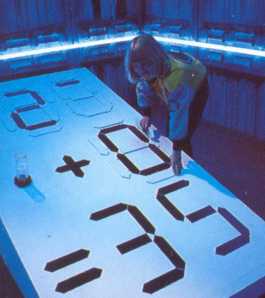 Contestant Emma tries to made a valid sum during a Christmas Special programme.
Contestant Emma tries to made a valid sum during a Christmas Special programme.A fact that wasn't lost on the programme's makers was that a staggering 40% of the audience watching the show were young (16 years old or less). The logic goes that the youngsters watched the show because they loved seeing all the adults make a complete fool of themselves by getting locked into rooms and falling into water tanks.
Four children's programmes were made. The first Children's Special in 1990 was in fact the first programme to be made from the recording for series 2, so it was a chance to see what games were in store for the 1991 series.
While most of the games played by the children were the same games played by the adults, a few of the cheaper games were constructed especially for the kid's show. In the game pictured above, contestant Emma is trying to make a sum by covering certain parts of an LCD display with hinged, white cards. However, some of the white cards are stuck down, so there is only one possible solution.
Other children-only games in future series involved a colour-association game popping balloons, and guiding a model land-surfer around a maze using a hand-held blowing machine.
Entering the maze
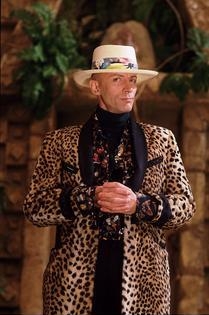 Richard O'Brien sporting this season's must-have fashions.
Richard O'Brien sporting this season's must-have fashions.While the emphasis was really on the games themselves, we also saw the team getting into the Maze at the beginning of the show. The first zone changed each week, and the process of entering the zone depended on which zone was to be entered, such as:
- Aztec - Paddle two four-person canoes down a short "river".
- Industrial - Climb over oil barrels and a wire mesh and/or open the gates with a key.
- Ocean - Remove a metal grille and make your way down a ship's rigging (sodden, dripping, scramble net).
- Medieval - Raise a portcullis, or climb over it.
- Futuristic (pictured) - Answer a scientific-themed question posed by the computer.
Moving between zones
As a linking device between the zones, there was a short obstacle course. These didn't affect the scoring of the programme in any way.
- Aztec to Industrial/Ocean - Crawl through a tunnel.
- Industrial/Ocean to Medieval - Climb up a ladder and crawl through a hatch.
- Medieval to Futuristic - Cross a log over a swamp.
- Futuristic to Aztec - Go up in a lift, then climb down the face of a stepped, steep wall.
New series, new presenter
Richard O'Brien left the programme at the end of series 4. The exact reason was never really established, although in a later interview Richard gave the following reason:
"The Crystal Maze was a road I walked down, I never imagined I'd go down that particular byway. I liked it but even at the time I thought - I never saw myself doing this kind of work. So I did it for four years and thought I better get out while I am ahead, while I am remembered fondly."
At the start of the 1993 Children's Special we had a short, one-minute introductory film which saw Richard O'Brien and Mumsy leaving the Maze on a Harley Davidson. Richard left a note for the new occupant:
"Ed, I know I'm leaving the Maze in safe hands. Remember to pay the milkman. Love, Rick."
The titles rolled and we were greeted by Edward ("but you can call me Ed") Tudor-Pole, the second Mazemaster. To be fair, Ed didn't do a bad job at all of presenting the Maze, it's just that Richard O'Brien was so good at improvising, hamming it up and going over the top that Ed seemed somewhat stilted in comparison. In addition, a recognisable proportion of people watched The Crystal Maze not for the games but to watch Richard O'Brien.
It don't stop there
Ed presented two series before Channel 4 and Chatsworth TV decided to call it a day. During its heyday, The Crystal Maze was the number one programme on Channel 4, raking in something between 4 million and 6 million viewers. It was a highly-ambitious, high-risk show that paid off handsomely.
The show may be gone but it is far from forgotten (how could it be?). Besides being twice voted the greatest UK game show of all time by readers of this very site, it has also been endlessly repeated on the specialist game show channel Challenge. For some years, there were also various Cyberdrome Crystal Maze attractions around the country - the last one, at Narberth in Pembrokeshire, kept going right up to June 2010. If you really want to play the game, and money and distance are no object - or you happen to live in the United Arab Emirates, in which case, hello! - you might like to know that thanks to the enormous popularity of reruns of the show out there, there's now a similar attraction in Dubai. Though with the obvious and crucial difference that, at the time of writing (summer 2010), it's still open. In addition, the programme on which The Crystal Maze was originally based is still going in its native France and subject to on-off revivals in the UK (see below).
Inventor
It's worth a moment to recount how The Crystal Maze was invented because, like many good things, it came about mainly by accident. Independent production company Chatsworth Television were originally going to make a show based on a French programme called Fort Boyard. Like some previous Chatsworth Television shows (Treasure Hunt and Interceptor), it was co-invented by Jacques Antoine.
However, it soon became apparent that the fort (which was having TV equipment and the games installed at the time) was not going to be ready in time for the pilot programme. So, the production team sat down and thought of a different way to make the programme along similar principles but without relying on the fort itself. Instead of winning keys (as is the objective in Boyard), crystals would be won for completing a game correctly. The zones were also introduced to give more variety. Also, the ending was very different - in Boyard, gold coins have to be collected whereas British audiences saw contestants leap about for gold tokens in a windy geodesic dome. Another difference was that the French show is played for charity and is 90 minutes long with no advert breaks! Apart from that, the basic principles were much the same.
It is somewhat ironic that, after The Crystal Maze ended, a British version of the Boyard programme (filmed in a Napoleonic sea fort off the west coast of France) was made by Channel 5 and later Challenge.
Theme music
Like the previous two shows produced by Chatsworth Television, Treasure Hunt and Interceptor, Zack Lawrence was on hand to compose the theme music. It was called "Forcefield".
Trivia
The Crystal Dome is a pentakis dodecahedron [1] and would have 60 faces if fully formed.
The worst ever score is one time crystal (the team won more than one game, but had a large number of lock-ins and forfeited one crystal for every person they had to get out). The best ever score is ten crystals which, to our knowledge, was scored twice - one team got 128, while the other still didn't manage to get over 100! The latter event happened in series 1, so at least they got the minor prizes.
The lowest ever score achieved inside the Crystal Dome was -66. This actually happened twice during the show's run: once under Richard in Series 4, and again under Ed in Series 5.
In Series 6, Ed would sometimes start the fans in the dome by saying "Let the four winds blow!". This is presumably a reference to Let the Four Winds Blow, which was the name of a song and album by Ed's punk rock band, Tenpole Tudor.
Ed next turned up in 1990 when he appeared in the London version of the Rocky Horror Show at the Piccadilly Theatre. He played the part of Riffraff, which coincidentally was originally played by Richard O'Brien! It was a few years later that he was signed up to present The Crystal Maze.
The show had the distinction of being mentioned in an episode of the BBC drama series This Life:
- Milly: "Why is life so complicated?"
- Anna: "It's not as complicated as The Crystal Maze. Now that is one complicated bastard."
The Crystal Maze was spoofed in an episode of top kids comedy Maid Marian and Her Merry Men. You can read the transcript and look at some pictures here.
The producers didn't have any money to afford a fee for Richard O'Brien to do the pilot show, so instead he asked for some very nice sandwiches for lunch.
At least twice, episodes were dedicated to contestants who had since died. In 1991, one episode was dedicated to contestant David MacPherson who died in a motorcycle accident, he was better known as Mac in the show as two of his team mates were also called David. They were called David, Dave and Mac respectively. In 1995, the final episode showed a dedication to contestant Jim Alexander who had died. This was only shown once when it was on Channel 4.
Merchandise
 Best of The Crystal Maze Video
Best of The Crystal Maze VideoPuzzle book by Peter Arnold, Gill Brown
Web links
Marc Gerrish's site with descriptions of all the games and masses of statistics.
Crystal Maze fan site - superb site by a German student that contains details of every game and show! (Via archive.org)
Videos
Other videos:
- 10 minute clip from the show
- Spoof - The Crystal Muck (Dick 'n Dom)
- Spoof - Punt and Dennis' Making a Cup of Tea game
- Spoof - Adam and Joe's Star Wars take off (warning: contains strong language)
Pictures
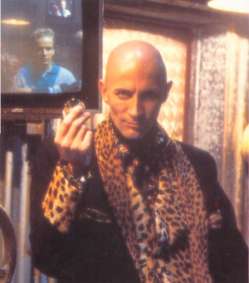 The host holding a time crystal, outside one of the Industrial zone rooms. The TV monitors were used by the teams to direct their team mates during the games.
The host holding a time crystal, outside one of the Industrial zone rooms. The TV monitors were used by the teams to direct their team mates during the games.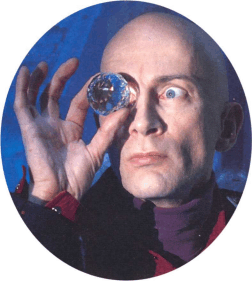 The host holding a crystal.
The host holding a crystal.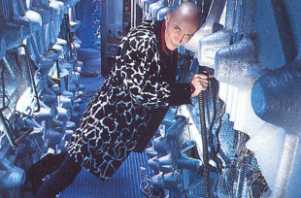 Richard O'Brien in one of the corridors connecting the game rooms in the Futuristic zone.
Richard O'Brien in one of the corridors connecting the game rooms in the Futuristic zone.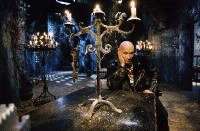 Richard O'Brien in the main hall of the Medieval zone.
Richard O'Brien in the main hall of the Medieval zone.
